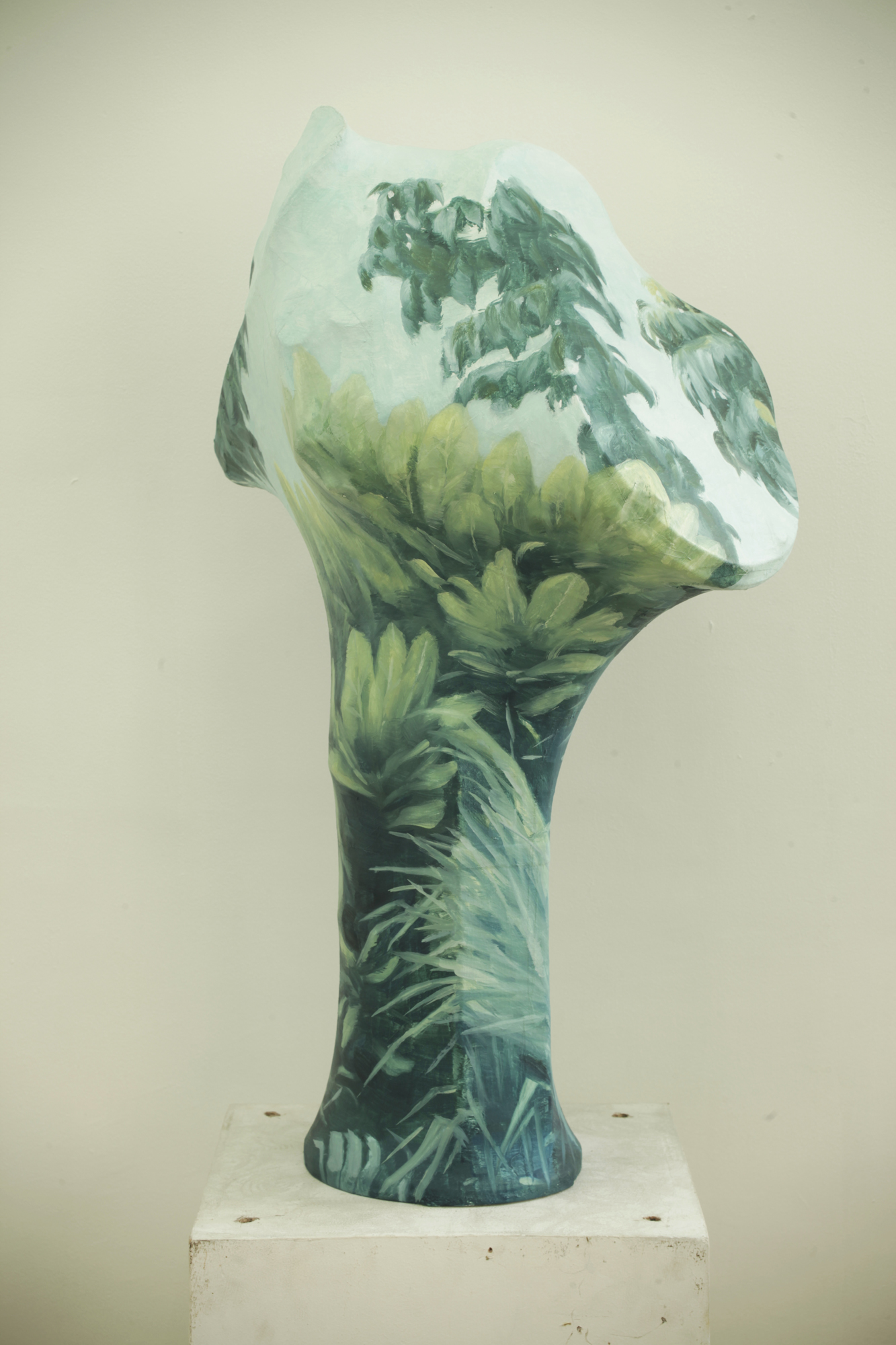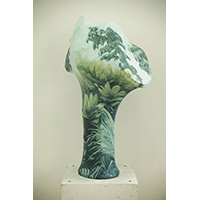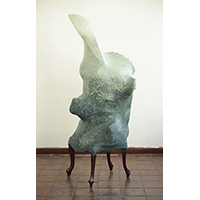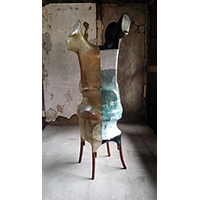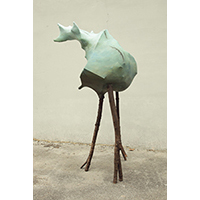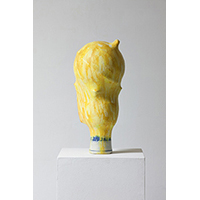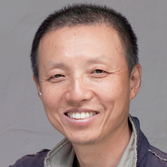
Soun HONG, Savina Museum of Contemporary Art
Birth
1959, Seoul
Genre
Painting, Installation, Photography
Homepage
Unconventional Landscapes and Image That Heal
The Recovery of the Landscape and Healing the Accident
Hong, Soun’s painting called
‘Sidescape’presents a new perspective on landscape art. His view of the
traditional landscape is that it is merely a visual representation of a specific
scene in nature using an arbitrary method. A landscape is a combination of
various components (such as mountains, trees, streets, and houses) which the
artist's eye plucks from the environment and puts into a frame according to the
composition and formation which is considered to be acceptable at the time.
That’s right-- without an exception, all landscapes are merely the result of a
union of a cropped worldview interspersed with fragments of nature which have
been brought into one’s frame.
Hong’s segmented, or fragmented, landscape,
‘Sidescape’, cannot be included in the conventional landscape genre without
some additional explanation. ‘Sidescape’ is a secondary result of a segmented
and fragmented landscape which has been re-segmented and re-fragmented. The
distinction between his painting and the conventional landscape genre comes
from the fact that 'Sidescape' internally contains many more components and
divisions. To the viewer, it is immediately obvious that his painting is true
to the specific object that it focuses on, whereas landscapes are composed with
the intention and purpose of depicting an entire scene. One of the primary
reasons why fragmented scenery is different from a conventional landscape has
to do with the cognitive mechanism. While a conventional landscape is a product
of a process that brings nature into a perceivable field of view, 'Sidescape'
shows only the fragmented parts of nature, and actually sends the object--
whether it’s a scene or an event-- beyond the range of perception and allows it
to return to the state it was in before it was perceived. 'Sidescape' is a
realm where the duty and responsibility of a landscape is unbound and the
essence of the event is liberated from the pressure of its contents.
Hong, Soun's 'Sidescape' painting is a
landscape which is composed of excerpts of one image. It is a cropped,
fragmented, deficient landscape. The source of this image is another image, not
actual scene in nature or an actual event. In his painting, nature is not an
unpredictable force. It is a contained element, similar to the way that
information from internet or mass media can be captured and consumed at any
time by any person. The event depicted in his painting is in a similar context.
The events that 'Sidescape' has chosen are not something that the artist has
collected while risking his life in the middle of a war on some deadly
battlefield. The source of all those events is just a series of images. The
source comes not from the events' origin, but from news footage of those
events.
The story of the image, whichever it is, is not
the focus of the work to Hong. Sometimes, it could be a historical turning
point or an important political event. In fact, the original photo of an image
is often related to war, a disaster, a controversial incident, or an
unfortunate accident. However, the event itself is not important at all.
Whatever it is, it is equally treated as a motive of the neutral landscape.
Hong is interested in the de-construction of an
event and the possibility of the aesthetic upheaval that results from the
de-construction rather than that which is inherent to the event itself. In
other words, it is about the beauty as a potential form which is difficult to
recognize because it is laid under the event and obscured by its contents. The
process of discovering scenery from the events as well as the process of
finding the splendid lights which survived curse and misfortune from tragic
battlefields and disaster are the best forms of symbolic healing treatment, are
they not? Hong extracts these events into a painting which gives a calm,
peaceful, and relaxing state of mind from an image that originated from heavy
and dark events. This process eliminates the root cause of despair and hatred
from horrific crimes and symbolizes the healing and reconciliation which eases
sensitive political tensions that stem from the conflict. It also symbolizes
the rescue of repressed images in the media and internet which are tangled with
inhuman politics and social events.
Fortunately, a few selected images by Hong were spared a terrible and
tragic fate, and have been preserved as part of his work.
To heal history, reconcile event and scenery,
and rescue the image from the news footage of the bloody, muddy political and
social mess, the perspective of 'Sidescape' shifts from the center of the
photography to its fringe. The next step is selecting individual parts of the
event. The standard of selection is that any piece, regardless of size, must
share the context of the entire situation while at the same time disconnect
itself from the situation. Thus, it should be dialectical. Then, the selected
and gathered parts go through a process of enlargement, depiction in paint, and
are then remade as an independent landscape which is connected to the event
dialectically. As you can see, 'Sidescape' is the aesthetic strategy which
dismembers the events from the political and social context. The journalistic
trait is de-constructed and re-constructed as the landscape through the image
fragmentation process. It is a process which fetches out the potential of the
image which was hidden in the events and gives beauty and life to the void in
the world of neutralism. Is this not the very duty of Art?
Unconventional
Landscape
Hong's cropping method used in 'Sidescape' is
irrelevant to the destruction or deconstruction of scenery. 'Sidescape's'
fundamental objective is the recovery of the scene, not a denial. Its objective
is also to reveal the aesthetic of the event which is hidden at its center and
to examine the potential of imagery that has been cropped from the scene to see
if it can be a landscape by itself. The particle which is detached and
fragmented from the whole is like an indicator of other scenery, which is not
at all a conventional way of perceiving a landscape. It's like a chapter of a
novel whose expression 'consists of endless monologue' or is a 'continuation of
silence'. It is reminiscient of Proust's writing, which allocates thirty pages
to the listing of images which come across the character’s mind before falling
into sleep instead of using a typical description, such as 'fell asleep like a
rock' or 'dropped like a log.' Like Proust's isolated and irrelevant words
which made the story seem coherent when we read between the lines, Hong's
painting conveys meaning when we "read between" its lines. Hong is
well aware of the fact that this unsatisfactory and indirect conversation is
the original method of the painting.
"Like our life always does, the painting
gets off the track of logic. When a painting, which is riddled with
uncertainties, is interpreted using the logical constructs of a critic, the
light of the painting fades away. Then, it becomes famous in the secular
world.” (Hong, Soun)
The process of creating a unified world composed
of a series of 'Sidescapes' by horizontal and vertical arrangements is very
interesting. They are neither edited nor censored. They create the open-ended
and writhing landscape before it becomes one of the conventional landscapes.
Through this unconventional landscape, Hong’s painting could be received as a
challenge to the conventional model of communication. It could be seen as an
intended, fabricated, uncomfortable and also impure communication. Hong himself
knows that his painting is unkind because of these reasons. However, this
unkindness will lead people to better communication by freeing them from the
binds of conventionalism and helping them realize that this conventionalism
will make them lose their own time by offering pretentious kindness.
Sim, Sang Yong / PhD., Fine Art, Dongduk Women’s University
The Right to Dream: Portrait Series
Hong, Soun has been
exploring various mediums including painting, print, installation, photography,
sculpture, and video. By bringing these three-dimensional works and forms as a
whole back to the basic canvas, he carries on the art historical legacy.
If we consider the series
which he has been working on for last ten years is the work that depicts the
entire scenery of this world by using the fragmented image, is a
portrait series. He has been exhibited Gypsy in the Czech Republic, Indian in
Santa Fe, and multi-cultured family in Korea. This series depicts the figures
who the participating children from culturally less-favored areas dreamed
about. They are imaginary figures in children’s dream such as future self
portrait, comic book heroes, avatars, and abstract figures which is different
than the reality. The children’s raw paintings showing their unpredictable and
pure imagination are overlapped on the portraits of children which Hong took.
Then, Hong edits them expressively and prints them out. Depending on the
exhibition space such as a church, school, and museum, he chooses proper
materials and installs the portrait series. It is the art of collaboration
which the objects (children), artist, and viewer are all participated in and
completed by interactions with participants rather than the work of a lone
artist which is the conventional characteristic of the painting emphasizing
artist’s genuine talent. Children’s intuitive and pure spirit is transferred to
the field of interaction and it will be discovered and shared with viewers
through the power of the imagination. The work is completed by this artistic
communication. The potential beauty comes from children’s social identities,
the perspective of the painting, and painterly quality of the photograph and
this variety is reminiscent of the right of art.
Kim, Mi jin / Professor, Fine Art Department, Hongik University, Exhibition Plan & Critic






